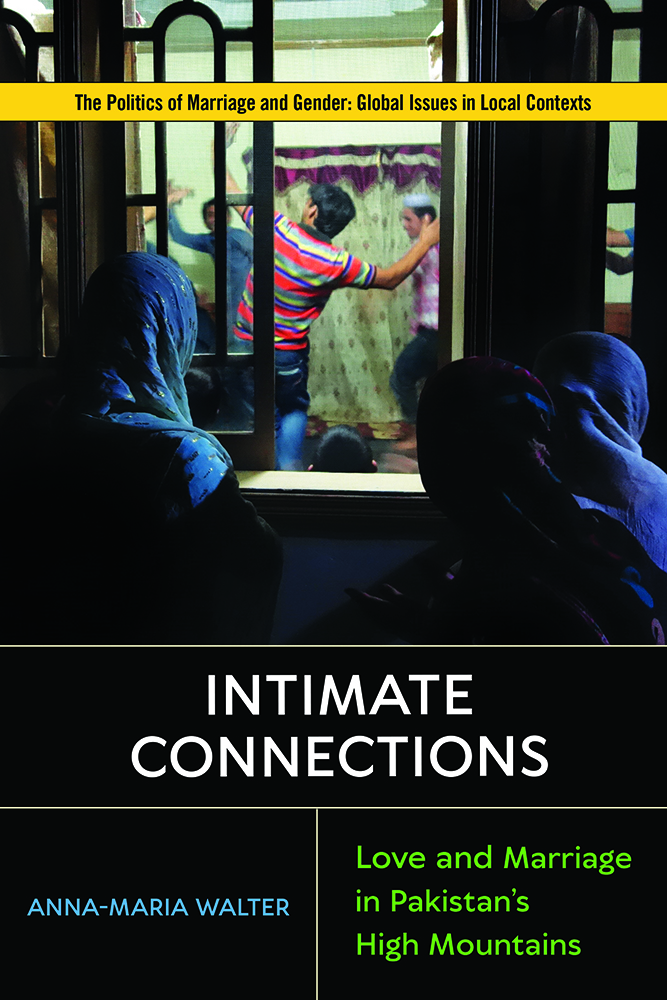What are emotions? What’s their role in relationships, in society? And what do they mean for the individual? Or rather, what is it to feel? And, what’s love got to do with it? In our latest ENPA blog post, Dr Anna-Maria Walter discusses her new book, Intimate Connections: Love and Marriage in Pakistan’s High Mountains.
by Anna-Maria Walter, Oulu University
The monograph Intimate Connections zooms in on the emotion of love. Examining (pre)marital intimacy in northern Pakistan, the book brings the interactive potential of feelings to the fore. Sensitive ethnographic accounts approach intimacy as constituting a sphere of familiarity and informality that is not inherently positive but could also give way to vile, abusive relations – nevertheless, emotions as social glue. What is currently happening in the area of Gilgit in the high mountain ranges of Gilgit-Baltistan, as in many other regions of South Asia, is that young women strive to redefine conjugal relationships by making romance part of arranged marriage. In a Muslim environment that is defined by parda, or values of gender segregation, young couples actively forge an intimate connection that often starts off over mobile phones and is then transferred into real-life encounters. Along the way, women use their embodied modesty or inner scale of sharm to gauge their behavior as well as their emotions.
A question that arose in a book talk in early April was: does romance and increasing (pre)marital intimacy translate into wider societal change? The discussant Ammara Maqsood, participating scholar Katherine Twamley, both from UCL, and the author, Anna-Maria Walter, teased out what such generational shifts actually mean for the role of women in Pakistan, in their families, and for the single person.
Emotionally charged, highly subjective ideas about love or decency often lie beyond words, not because they necessarily are taboo to talk about, but because they are difficult to articulate in linguistic terms—though this itself might to some extent reflect a certain level of taboo. If a feeling is not expressed in emotional terms, it does not mean that it does not occur. Moreover, the researcher cannot simply rely on terminology or autobiographical interviews because language is often heavily reliant on idioms that frame feelings through a cultural prism [1]. Fondness between spouses, for example, can only be detected through the soft voices with which they speak about each other, the meaningful eye contact they exchange, the mutually playful ways they tease one another, the fact that they may rarely spend a night apart, or the devotion with which they attend to one another’s ailments and happiness.
As additions to more discursive analyses, such experience-based approaches have been criticized for their radical subjectivity that might romanticize instead of deconstruct structural inequalities. But they can establish alternatives to the mainstream discourse of a “patriarchal rationalism,” [2] centering individual experience in a way that facilitates the dissection of power and agency in the cause of local women. Emotions allow, or even call for, an integrative approach to social life that takes different directions of experience and embodiment into consideration, thus offering a chance to productively tap rich anthropological debates of mind and body.
Given the prevalence of close-knit kinship systems in South Asia, scholarship on the region has a long tradition of pondering the relationships between the individual and the collective. Observations that social hierarchies often overrule personal autonomy have led anthropologists to conceptualize persons as dividuals, emphasizing their divisibility that allows for flexible adjustment to social influences [3,4,5]. While challenging the Cartesian model of an independent, thinking self, which effectively lacks the congruency of a secluded interiority, such projects were heavily critiqued as simplifying local realities and denying (non-Euro-American) people’s potential for introspection [Ram in 6, 7]. They have, however, prepared the ground for anthropology’s increasing awareness that self-perception is inevitably a product of enmeshment with the social environment [8].
While early scholarship on emotions wrestled with the conceptualizations of a “private, closed-in subject confronting the external, public world” [9], recent thinkers argue that we should see selfhood universally as more or less porous [10], with permeable boundaries for social forces and meanings, or as Tim Ingold puts it, as an ever-changing organism in social relations [9]. Accordingly, emotions are a way of relating to the world. As forces that emerge from interaction, feelings integrate a person’s conscious and unconscious, both of which are embedded in a socio-historic context. To unfold what seems to be a long-standing theoretical impediment, we must pay close attention to the entanglement of emotions and the body.
The mind is not an abstract computer encapsulated in the body: The body itself is “the instrument by which information and knowledge is received and meaning is generated” [11]. The anthropologist-cum-sociologist Pierre Bourdieu identifies the “socially informed body” as key to a person’s perception of reality [12]. Through practice, social habits become internalized and structure all subsequent experiences—one’s line of thought, one’s demeanor, taste, and emotions—in what Bourdieu famously calls the habitus. Once one has grasped the underlying rationale, it is unnecessary to learn every behavior from scratch; we know intuitively what to think and feel. Embodied social knowledge provides us with what Bourdieu calls a “feel for the game” [13], but the game can well be influenced by its players. What’s more, incorporated habitus and performative acts mutually amplify and reproduce each other [14]. In Gilgit, women who adhere to parda rules, such as maintaining a downcast posture and averting their eyes when in public, simultaneously express subconscious feelings, repeat expected models of behavior and reinforce that behavior for others.

The sensations of sharm start imprinting themselves from earliest childhood on. When Zoha, a baby girl not yet two years old, spotted her uncle’s bare arms sticking out from his Western-style T-shirt, she pointed at him and shouted an exclamation that signals shameless conduct: “Vī‘ū, vī‘ū, vī‘ū!” Although a man’s naked arms do not violate sharm, Zoha, having already begun to absorb the underlying structures of modest conduct, was alert to the potential for misbehavior. Within a few years, she will be playing with a little veil, learning to handle the additional cloth, and gradually getting used to the feeling of wearing it herself. She will eventually become so accustomed to the covering of her head, to the sensation of fabric around the edges of her face, to the weight of the fabric flowing down her neck and resting on her shoulders, that not veiling will make her feel incompletely dressed and “naked.”
Social rules may precede the individual, but they only become reality through people’s performance and action. Based on an elaborate discussion of speech acts, the feminist philosopher Judith Butler [15] credits all actions—and speech is but one specific configuration of an act—with performative power in the production of the subject: Whatever we do or react to has an effect. According to Hanafi jurisprudence, a Sunni husband can pronounce divorce by repeating the word t̤alāq (divorce) three times in a row and the marriage will immediately be dissolved. The utterance works not on its own, but because it takes place within a context that recognizes its meaning. Hence, Butler’s performativity points to the fact that a person does not perform a certain role, but her acts are performative for the self. From action, sensory perception derives, so repeated behavior becomes unconsciously incorporated and affects the mind. In her newer work, Senses of the Subject, Butler zeroes in on the materiality of the bodily habitus that enacts norms at the same time as it constitutes the subject. Since norms do not exist independently of lived social life and need to be enacted. enacted, they are vulnerable, unstable, and flexible. People can fail to perpetuate them, or re-appropriate them instead of merely consolidating them. In this way, Butler has not only added another layer of the radical constructive character of social life to our understanding but has also recovered the agential role of each individual, person, or subject in the bigger whole: “The task is to think of being acted on and acting as simultaneous, and not only as a sequence” [16].
Based on her observations in Egypt’s mosque movement and her female protagonists’ conscious mobilization of the body-mind interconnection, Saba Mahmood recognizes agency to unfold in the “multiple ways in which one inhabits norms” [17], stressing people’s creative quality of bringing patterns to life by enacting them. Although we make “sense” on the basis of what we already know, and although established epistemologies guide our thoughts and actions, our ever-growing pool of experiences contributes to change. Even individuals thereby penetrate established structures, and open up the possibility for deviation, creativity, and modulation. On the basis of already incorporated knowledge contesting sets of moralities as well as external influences offer “potentiality” [18] for (re)assessment and (re)enactment of practices and values as well as emotions.
In her book the Cultural Politics of Emotion, feminist scholar Sara Ahmed shows how emotions are motivational forces that can bind entangled agents together or that, equally, may drive them apart. Ahmed concludes that emotions are created in public and circulate between agents, thereby constituting the very objects who feel them [19]. As feelings are the fuel for the interplay between individual and society, their dyadic character is crucial for one’s self-formation as well as forges collective bodies. This political dimension of collective experiences undergoes an intensification in François Laplantine’s work on sensory perception. He foregrounds the tangible aspects of “experiencing together”: We literally make sense together in daily activities of eating, suffering, chatting, or, in fact, loving—a process he calls the “politics of the sensible” [20]. Combining both approaches, I aim to describe a cultural politics of the intimate, alert to both the sensing components in meaning-making and to cultural context.
The polysemy of the term “sensible” captures both the phenomenological and epistemological aspects of perception and meaning making. To be sensible is to be tangible or noticeable, and at the same time reasonable and intelligible. Adding a materialist nuance to the social-constructivist tendency of anthropology, emphasis lies neither on being (structure) nor doing (agency) but on sensing and embodying one’s acts, thus feeling as structuring principle.
Attuned to the semantics and pragmatics of emotions, Intimate Connections seeks to mobilize this link between individual perception and the social collective. As transmitting forces, emotions prompt negotiation and open the possibility for creative action. Intimacy poignantly captures the interpersonal, intersubjective orientation of emotions that communicate between, even consolidate the typical polarity of socio-cultural conditioning and people’s agentive potential. So does love. It manifests between people, and, as the book’s protagonists from Gilgit-Baltistan help us to see, is not only felt spontaneously but is actively forged through intimate interactions. Politics of the intimate live up to people’s efforts to navigate their emotional connections within the (un)conscious constraints of a multipolar meshwork shaped by historical, ideological, and societal discourses.
A young woman from Gilgit’s suburbs, who had recently moved to her husband’s, testified on the social dimension of a very private bond of intimacy:
“When we suddenly got engaged, I didn’t know anything about him [my husband]. It would have been really difficult to adjust in his house like that. But we started talking on the phone, sometimes went out and met each other, so that we got used to each other.”
Couples increasingly use mobile phones to bond before their marriage is fully implemented. This way, they are better prepared for their life together, which is especially important for a bride arriving in a new family: an intimate complicity with her husband can disempower her in-laws.
Young women today also embody sharm but as they actively forge conjugal intimacy with their future spouses, they renegotiate such emotions. Depending on their individual personalities and domestic environments, couples who communicate before they live together contribute to shifts in gender relations. They mobilize the rhetoric of love for more mutuality and equality, build their confidence through small successes and make subtle demands – romantic love as grassroots project of emancipation within the family.
If you’re interested in purchasing Intimate Connections: Love and Marriage in Pakistan’s High Mountains, please find more information and promotional codes here.
About the author

Anna-Maria Walter has worked on the anthropology of emotions, gender relations and mobile phones in the high mountains of Gilgit, northern Pakistan. After completing her PhD at LMU Munich, where she also held a lectureship, she is now a postdoctoral researcher at Oulu University working in the interdisciplinary EU-Russian project CONTOURS.
In her current research, Anna-Maria works on perceptions of mountain landscapes in the Himalayas and the Alps, the socio-ecological dimensions of Alpine ski touring, digital anthropology and conceptions of the self through social media use – for more on that see her latest article in the American Ethnologist. She can be reached on: Anna-Maria.Walter@oulu.fi

Leave a Reply